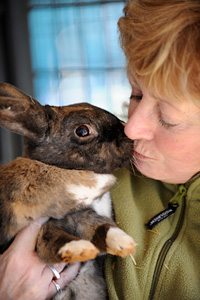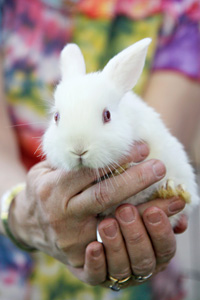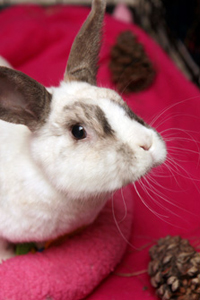Beyond the Bunny House
 Wow! A week of bunnies on the Best Friends website. With the hope that you will enjoy learning about these intelligent, curious and furry beauties, let’s get a head start on exploring a rabbit’s tale and get an up close and personal view.
Wow! A week of bunnies on the Best Friends website. With the hope that you will enjoy learning about these intelligent, curious and furry beauties, let’s get a head start on exploring a rabbit’s tale and get an up close and personal view.
In some ways, living with a rabbit is similar to being in the company of a cat or dog. Rabbits play, love a snuggly place to rest, get excited about breakfast, and have the capacity for loving us and showing their affection. If your experience with rabbits has only been to view them in a lonely backyard hutch, you have missed out on watching rabbits leap into the air and run the Bunny Indy 500 around a yard, just for the pure joy of it; feeling bunnies give you a “nose bump,” which means “pay attention to me”; watching rabbits get away with something they are not supposed to do; or seeing bunnies flick their heels as they hop away and do a “head shake” in delight. You will be amazed at their sense of humor and degree of annoyance, usually shown by thumping their back feet and then turning their back on you! Rabbits are social and will bond closely with a rabbit friend, grieving deeply if that friend is lost. You will find yourself saying, “I never knew.”
It can take a while to build a trusting friendship with a rabbit; after all, bunnies are prey animals. However, getting to know a rabbit is, well, just priceless!
For most of us, our knowledge of rabbits comes from popular culture, which depicts rabbits as cuddly, docile creatures that are especially popular at Easter time. We see and collect ceramic rabbits, buy purple and pink stuffed bunnies, and watch cottontails and hares bound through fields. Our domestic rabbits are most closely related to the European wild rabbit. These wild rabbits make their homes in underground warrens, live in complex social systems, and have amazing communication methods. All of these behaviors can be seen in our companion rabbits that number over 5 million in the United States. (For information on caring for your bunny click here for rabbit resources.)
(For information on caring for your bunny click here for rabbit resources.)
Rabbits continue to be a misunderstood species. Besides being sold as pets, they are raised for food and fur and used as research animals. And, sadly, rabbits are the third most abandoned animals in shelters today. Many do not even make it to a shelter when unwanted, but are simply “let go” to fend for themselves. It is a mistake to believe that a domestic rabbit will last very long on his or her own.
Visitors who come to the Bunny House at Best Friends often ask us where our rabbits come from and how they end up here. The Rabbit Department at Best Friends is a last chance resort for abandoned, sick or deemed-unadoptable rabbits. They come to us from shelters where their time has “run out”; some are abandonment cases, and others are from hoarding and abuse situations. In some cases, the rabbit’s people have a hardship, such as illness, and can no longer care for their animal.
Each case is worked by the Community Animal Assistance Department at Best Friends. Often, helping the rabbit’s person to understand bunny behavior and suggesting adaptations to the rabbit’s environment gives the individual the knowledge he or she needs to keep the animal.
When rabbits are admitted to Best Friends Rabbit Department, they are given a health check up and spayed or neutered. They are carefully introduced to a rabbit friend as rabbits are very happy and comforted by having a companion of their choosing. Not to worry, though, there is still room for us humans in their lives, too. The rabbit caregiver staff goes above and beyond to give the rabbits a stimulating and enriching home at the Bunny House while they wait for their own special family. If you visit the rabbits at Best Friends, you will see spacious runs filled with tunnels for bunnies to explore, wicker baskets to chew on, balls to push around, “hidey boxes,” and soft blankets for those mid-day “lazies.” Almost forgot to mention that we have a daily tour at the Bunny House, and, of course, love volunteers to help us with the bunnies.
When Best Friends is contacted about unwanted or abandoned rabbits, it is not unusual to find that there are not just one or two rabbits needing homes but often hundreds. In 1996, Best Friends was able to rescue 187 rabbits from a backyard in Las Vegas. The person started with a few rabbits and before long the number climbed, and she could no longer care for them. She said she did not know that rabbits can be spayed or neutered. Many people still do not know how necessary spaying/neutering is not only for preventing unwanted births but also for the general health and well-being of rabbits.
Each year, the number of rabbits living on college campus, schools, zoo grounds, public parks and in other areas is increasing. Most of these innocent souls are eventually destroyed. There is hope, though! For example, a small group of dedicated teachers, students and community members decided to try a trap/neuter/return (TNR) program for the feral domestic rabbits living on the campus of Long Beach City College in California. With some help from Best Friends, all the campus rabbits were spayed or neutered and many have been adopted.
We at the Bunny House get so much joy from getting to know our individual rabbits’ personalities. We will never forget Smokey, a handsome gray rabbit who loved to visit with all the other rabbits, often taking his siesta just outside of another rabbit’s run; little Heathcliff, one of our Guardian Angel rabbits, who came with a police “rap” sheet; and Baby Blue, who liked nothing better than sitting in the middle of a staff conversation. Wonder what he was thinking? To bring the wonderful, magical world of rabbits into your home, adopt one of your own! And don't forget to check out Rabbit Week for more bunny fun!
